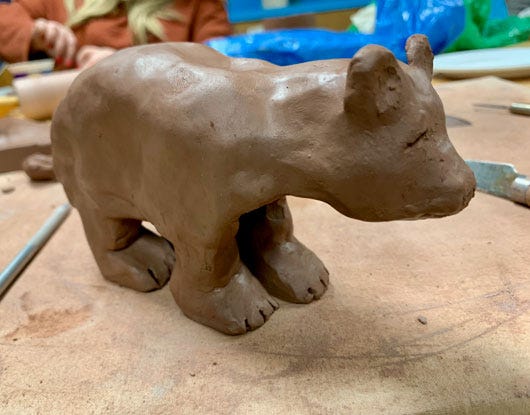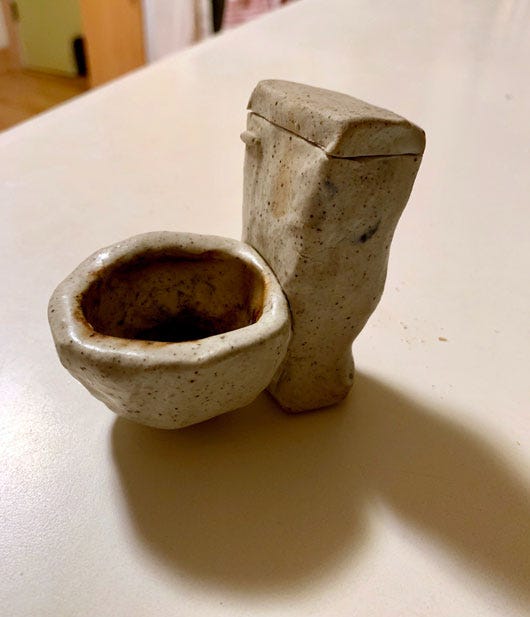Art Report From the Front Lines: Minneapolis Community Ed Pottery
I was kinda sick when I wrote this, hope it doesn’t ramble
Way back when I was laying out the parameters of what this newsletter would be, deep in the last decade, I said that sometimes it’d cover making art, too; I guess this is one of those times.

Hey, there,
The decision to take a Community Ed pottery class wasn’t a hard one. I’d taken one pottery class previously, at the very end of undergrad,* and absolutely loved it. I remembered the excitement of, for the first time in 4 years of higher education, learning to do something with my hands. I remembered the satisfaction of seeing and feeling a form come together. I remembered the intense physical sensation of working with something on the wheel. The way glazes seemed like a fascinating, bottomless pool you could dive into and just get lost in. The feeling of my head going from total confusion to calm understanding under calm, patient tutelage.
*My undergrad class selection was done kind of badly; I came in as a physics major and spent about the first half of college being a snotty STEM kid and taking math and science classes. Then I recognized that I was miserable, switched my major to English, and had to cram an entire major into 5 quarters. While I was feverishly finishing my English major, I rounded out my schedule with “fun” classes that I was taking pass/fail. The last two of those fun classes were an art history survey class and a studio pottery class, and as I sat through and loved these art classes, I started to wonder if I hadn’t made a huge mistake with my whole educational program. 20 years and a haphazard wander into grad school would eventually fix this error.
My home office is still littered with stuff I made in the undergrad pottery class. I have a bunch of incense sticking out of a square vase. I occasionally burn incense cones in a little porcelain toilet that I made (complete with blue glaze in the bowl to look like water), that I once got in trouble for putting in my desk when I worked in a curatorial department at the Minneapolis Institute of Art (“this is a place only for beautiful things,” my boss, the curator of textiles told me, as she figured out what her display options where for a brown jute fiber art piece that looked, as a friend of mine described it, “like a buffalo’s vulva.”) That class and its artifacts were nothing but pleasant memories, even if every ounce of the knowledge involved had evaporated from my brain. A community ed class to refresh it all and make winter easier to handle? Again, no-brainer.

It wasn’t easy getting into the class! The first time I tried, the class had filled up within an hour and a half of registration opening. So I waited until the next semester and registered literally 2 minutes after registration opened; the class was full within 20 minutes. The people of Minneapolis want to learn their beginning pottery.
So anyway, I was hopeful about a month ago when class kicked off. Finally! Finally I was going to re-engage with the first visual art I’d ever really done, the only type of visual art I’d ever had any formal training in, however brief. IT’S ART TIME, YOU SONSABITCHES. I kept this buoyant feeling as I found my way to class, in an elementary school in Northeast Minneapolis. It was a little trippy walking into an elementary school for a class, but hey; everything worth doing is a little weird. All systems go, I figured. Having little-kid drawings on the walls as we worked would just add to the fun and maybe spark some creativity, right?
I’m afraid to report that these hopes have crashed down steadily as the class has progressed. A big part of this is the woman teaching it, who I’ll call Martha. Martha’s a pretty interesting ceramic sculptor, but she’s not a very good teacher.* Or even a person very interested in teaching. Her pedagogical technique is to rush through something--say, building on the wheel--really quickly while delivering a muttered, digressive monologue as she goes; it is nearly impossible to extract usable information from these presentations. These demos take up maybe 15 minutes of each 2-hour class session. She spends the rest of the time just sort of abiding, talking to the room or to individuals as we huddle over our little projects, complaining to us about how nobody buys her sculptures, how nobody gives her grants, how the other teachers sharing the course’s kilns are dumb, how her family has a bunch of quite-real-but-maybe-not-the-thing-to-dump-on-your-community-ed-students problems, and on, and on. Ultimately, she reminds me of an unfortunately common personality to run across in the art world: the person who is a moderate amount of talent wrapped around a gigantic need for attention and unfocused validation. I don’t think Martha’s a bad person, but she definitely is in a headspace that’s not great for education; I didn’t walk into that class expecting to hear about her daughter’s struggles working at a downtown strip club, but here we are.
*And quick note here: I’ve taken other Mpls Community Ed classes that were great experiences led by great teachers. It’s a kickass system! Usually.
The teaching situation isn’t helped by some of the students. Most of the students are great! Or at least they’re run of the mill community ed students. Normal, chill people who just want to learn some basic pottery. But. But. The first night of class, I learned part of why registration is so hard: because there’s a core of about 8 people (in a 16-person class) who register every term and just treat the class as their weekly hangout session. This certainly doesn’t help with Martha’s focus on teaching. Included in that group of 8 is a family unit consisting of two 20sish women (“the grandbabies”) who are essentially there to hang out uncontroversially and work on pottery, a 90sish woman we’ll call Thelma, and a woman about my age we’ll call Kim.
And Kim and and Thelma are kind of destructive to the class. Thelma’s a very nice person, but appears to be suffering from rather advanced dementia; she spends each class asking where she is, asking if Martha is an old friend of hers, asking if these pots are for sale, and so on. I don’t intend to make fun of her for this; I can just barely imagine how upsetting it must be to have to deal with a beloved family member experiencing these problems. But I also submit as an innocent bystander that all of this adds a pretty destabilizing energy to a class. Even moreso when Kim, in what is either a coping mechanism or a garden-variety desire for attention, will often engage Thelma in comedy bits for the benefit of the room. “Tell the folks what winter’s like in South Dakota, grandma! Why don’t you tell us all about that crazy dream you had!”
The class is just about done, and it’s fine for what it is. I’ve learned not to expect to really learn anything beyond getting some practice on handbuilding techniques I vaguely remember (my one attempt to get back on the wheel was disastrous, as have everyone else’s, with Martha too occupied to come over and walk anyone through the process again, even when asked; now the two wheels just sit unused on the side of the classroom). I’ve made a few lumpy projects, and I’ll probably crank out a few more before things wind down, and when it’s all over, I guess I’ll reevaluate whether I want to go take a more structured class somewhere else, or just drift back to drawing birds and making podcasts.
In the meantime, I can’t wait to hear whether or not Martha’s daughter ends up getting that pet snake.
RECOMMENDATION
Anna Wiener’s Uncanny Valley, a memoir about working in Silicon Valley, was both really run and really angry-making. Wiener does a great job of capturing the vacuity and existential dumbness of the sector that’s steadily eating the American economy. But what really makes the book special is her psychological insight as she spends basically the entire book putting her younger self on trial for complicity. Awesome book, quick read, and wow is there a lot of harrowing subtext lurking just underneath the prose.
SOME LINKS
Twitter can be problematic, but it can also be great, as with this account that is just cats photoshopped into pictures of military equipment at ridiculous scale.
Or, as far as that goes, this one that pairs images of intense-looking cats with black metal lyrics.
Even less art-related, but maybe worth your time: I complain a lot about CBS news, but this segment that uses pie to explain American wealth inequality to mallgoers is really well-done.
CLOSING STUFF
OK, so here at the bottom, sorry for the ragged copy editing; my deal with myself was to keep this fast and loose, which is gonna mean typos. On the other hand, that also means it’ll actually come out, instead of being obsessed over.
If you have any thoughts/reactions/what have you about this, I’d love to hear about it, either by email or on Twitter. And if you know anybody who might dig this, please forward it on to them, or send ‘em the signup link! And thanks!

